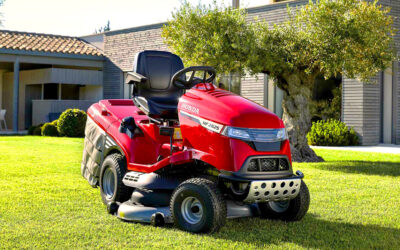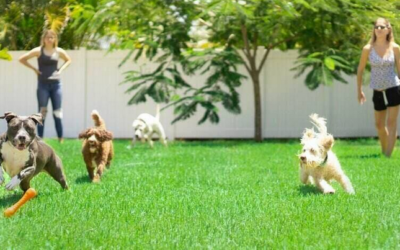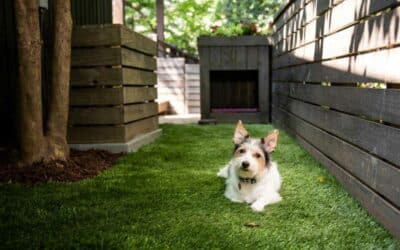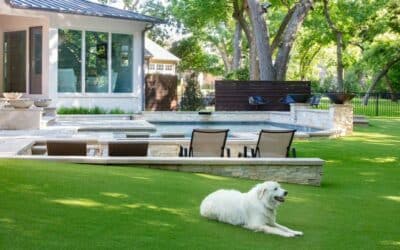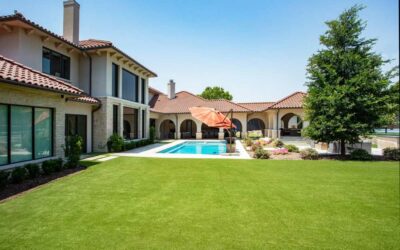If you choose the right artificial grass, have it installed properly, and take a few simple steps to look after it, you should have few issues with smells and most people find that the initial costs of artificial turf are more than worth it.
However, if your synthetic turf starts to develop unwanted smells, this can sour the experience. Dog owners, especially, can run into unpleasant fumes or landscaped lawn systems can develop mold that causes unwanted odors if important measures are overlooked or neglected during installation or maintenance.
To prevent artificial grass smell, you need to deal with the root causes of the unwanted odors. The good news is that most smells from artificial turf can be avoided or, at least, managed.
Here’s what you need to know about how to prevent artificial grass smells…
Why does artificial grass smell?

If your artificial grass smells, there are two main lines of investigation:
- Do you have pets?
- When was the last time you checked for mold?
If you have pets, your pet turf area may smell because urine doesn’t drain away properly. The main culprit is urea, which can lead to ammonia-like smells emanating from the area, especially in the heat and humidity and when there is a lack of rainfall to wash the pee away.
The underlying cause of the smell could be poor installation, poor choice of infill or poor management of the area.
Despite the fears of some dog owners, dogs can pee on synthetic turf—and there are many well-established benefits of artificial grass for dog owners compared with real grass. It’s used extensively in dog runs, dog parks, dog kennels, and other dog-friendly backyard areas.
However, precautions must be taken to prevent unwanted smells (more about this below).
If you don’t have any dogs but your artificial grass still smells, it could be the musty odor of mold or mildew forming on your turf. The underlying causes of this could be poor artificial grass drainage and/or lack of turf maintenance.
With poor drainage, heavy rainfall may build up on your lawn and cause the ideal conditions for mold and mildew to form. This smells unpleasant and it can also lead to health problems in extreme cases.
Does artificial grass smell after rain?
If your artificial turf smells after rain, it’s likely due to mold or mildew rather than pet pee. Excessive rainfall coupled with poor drainage from a sub-standard installation can cause water to pool on the surface of the grass.

These are ideal conditions for mold and bacteria to grow, especially if the rainfall is combined with heat and a lack of airflow.
How to prevent artificial grass smell?
Prevention is much better than cure for unwanted artificial grass odors.
The most basic steps to prevent smells are taken at the beginning of the installation process—and involve a little ongoing work too (but not much).
There are three simple steps. You’ll need to choose the right artificial grass, install it properly, and then look after it…
Choose the right grass
Low-quality artificial grass may smell naturally more than better-quality turf. It may also be less tolerant of the heat and sunshine, causing unwanted chemical odors.
The backing of the turf you choose is also important. Lower-quality turf may have lower-quality backing, making it less permeable to fluids, which can disrupt drainage. Turf that uses latex backing should generally be avoided if you have pets as it can trap unwanted odors.
All turf installed by DFW Turf Solutions uses a highly permeable polyurethane backing that is non-absorbent, provides excellent drainage, doesn’t trap smells, and is washable.

Install it professionally
Poor drainage preparation before the turf is installed, incorrect placement of membranes, and inferior infill products can all contribute to artificial grass smells, especially if you have dogs.
If the right synthetic grass is installed properly, it should be able to handle whatever the elements and your pets can throw at it. Fluids will drain away without causing pee odors or moldy smells that prevent you and your family from enjoying your lawn area.
What you put under artificial turf matters. A lot. Installing turf is much more involved than simply flattening the area and rolling out a carpet of grass.
Synthetic grass Installation is really the subject of another blog post but some important elements to bear in mind are:
- A compacted, permeable sub-base layer made of aggregate and granite dust/chippings should sit below the artificial grass to allow liquids to pass through for drainage. Do not use sand as it will not compact properly and may cause sagging, as well as trapping odors.
- The best artificial grass for dogs should feature a deodorizer layer installed below it.
- Do not install a weed membrane over the base layer as this will trap moisture/odors (if you’re worried about weeds, use a non-toxic weedkiller).
- Any membrane used should be high quality with a mat backing and placed underneath the foundations (sub-base layer) of the turf rather than directly underneath it.

The final step before you’re ready to use your artificial grass area is to add infill. This is a type of “dressing” made up of a granular material. It is laid on top of the artificial grass and used to keep the blades standing upright and looking realistic.
If you have dogs, you should use a special, highly absorbent, antimicrobial infill not made from sand (which will retain dog pee smells). A zeolite-based infill is perfect because of its natural honeycomb-like structure that absorbs pet pee odors.
If you have dog pee smells on your artificial turf and you’re not sure where they’re coming from, check the infill, as it’s often the culprit.

At DFW Turf Solutions, we ask plenty of questions before the ground is broken in the backyard. We want to know if you have pets and the intended usage of the turf area so that we can adequately prepare above and below the ground for laying the turf. Careful installation will prevent artificial grass smells.
Look after it
A big reason for homeowners choosing artificial grass over real grass is its low-maintenance properties. But that doesn’t mean it requires no upkeep.
No regular watering, cutting, trimming, aerating or fertilizing are sure things. But you’ll need to take a few steps to prevent smells, especially when taking care of artificial grass with pets.
These include:
- Rinsing the turf with water from the garden hose at least once a month (once a week during drier spells, if possible).
- Removing any solid waste or debris as soon as possible to avoid bacteria buildup.
- Topping up the infill from time to time and ensure it is applied evenly across the area.
- Removing the old infill and replace it periodically if it starts to develop unwanted odors.
- Occasionally deep cleaning the turf fibers with an enzyme-based cleaner.
These steps should take little of your time compared with tending real grass and will help keep an artificial lawn looking and smelling fresh.

Note that if you have more than one large dog in a small area, more regular maintenance will be required to prevent artificial grass smells. You’ll also need to do more during hot and dry weather if you have dogs.
What to do if your artificial grass lawn smells
If your artificial grass smells and you suspect an installation problem, you may require professional assistance to fix it.
However, if the problem relates to something “above ground”, you can take certain steps to attempt to remedy the issue.

If your synthetic grass smells of dog pee
Dog pee is one of the main offenders when it comes to ruining backyard ideas with artificial grass. In times of heavy rain, the odors may be washed away but they can become overpowering if they are left to gather in hot, dry weather.
You can try these steps to remove the smell:
Apply an enzyme-based cleaner or disinfect it
Because uric acid is not water-soluble, water alone won’t clear away the unpleasant smell.
Specialist artificial grass cleaners are abundant. Though you should be wary about overpromises from the manufacturers, some tested products are very affordable and seem to be effective in removing all sorts of smells from artificial grass, neutralizing odors, and killing bacteria.
Most of these products can sprayed on the affected areas by attaching to the garden hose. Once left to work their magic., they need to be rinsed away. Always follow the instructions on the container.
We recommend using a good eco-friendly enzyme-based cleaner. These are generally more powerful than traditional cleaning liquids because they attack the source of the odors: breaking down stubborn uric acid and getting rid of pungent smells more permanently.

If you don’t want to use an enzyme-based cleaner, a broad-spectrum, heavy-duty disinfectant will also remove most pet pee smells. Some people find that these leave their own strong smell behind, though.
Zoflora products are diluted in water and contain fragrance so they leave a perfumed smell behind on your grass after cleaning and disinfecting an area.
Replace the existing infill
If the existing infill is saturated with dog pee and producing unwanted odors, you’ll need to replace it with a suitable antimicrobial version.
With most good antimicrobial infills and sufficient rainfall, pet pee odors will be neutralized and washed away. So, here’s what you need to do:
- Clean out the old infill: vacuum up the old smelly infill and dispose of it.
- Deep clean the turf: some of the smells of the old infill will have permeated to the turf fibers so it’s best to clean these with an enzyme-based cleaning solution (see above).
- Evenly spread an antimicrobial infill on the turf using a plastic leaf rake or nylon brush: around two or three pounds per square foot should do the job.

If your artificial grass smells of mold
Mold smells should be a little easier to eliminate than pet pee, which is notoriously stubborn. Again, it’s best to use natural, eco-friendly solutions so that you don’t unnecessarily add to the toxic load for you and your family.
Find the mold and gently remove any visible signs using a standard household detergent and water. Then you can try the following steps:
Apply diluted white vinegar
Spray white vinegar diluted in equal parts with water on the artificial grass area smelling of mold. Then, leave it for about 10 minutes and rinse with the garden hose.
This process should neutralize the smell of mold. If it returns, repeat the process. Bear in mind that the area may have a vinegary smell for a time.

Sprinkle with a natural deodorizer
You can also try sprinkling moldy areas with a natural turf deodorizer, such as baking soda. Let the baking soda sit on the turf for 20 minutes before sweeping or vacuuming away.
It’s best to do this when you’re changing the infill. That way, you can deep clean and deodorize the area before replacing the infill.

FAQs
Can you use bleach on artificial grass?
Undiluted bleach should not be used on artificial grass as it can cause discoloration and other damage. If you insist on using bleach, use a simple 5-10% solution of bleach and water and rinse the lawn thoroughly afterward.
How do you remove solid dog waste from artificial grass?
Remove solid waste from artificial grass as soon as possible as you would with real grass. Collect the waste with a bag or scoop, rinse the area with water, apply a disinfectant cleaner, and then rinse with water again.
How often should I clean my artificial grass?
This depends. If you have dogs, a weekly rinse would be beneficial in the hotter, drier months. At other times, once a month will help. If you don’t have dogs and your turf was installed correctly with adequate drainage, an occasional spray with the hose will help keep it fresh but the most important thing is to keep it clear of debris, which can attract bacteria.

Customized and odor-free artificial grass…
Preventing smells with artificial grass starts with choosing the right turf and installing it properly. Then, if you look after it, you should have few issues with unwanted odors.
However, if the turf was installed some time ago and you’re noticing moldy or pet pee smells, you’ll need to troubleshoot the problem and will likely need to change the infill or apply an appropriate cleaner to remove the smell. We’ve covered the main culprits and remedies above.
If you’re unsure whether you need to rip up your turf and start again because of installation issues or are considering switching from real grass to artificial grass, speak to our experienced team of turf professionals. We’ve helped homeowners enjoy customized, picturesque, odor-free areas in their front and back yards for many years…

